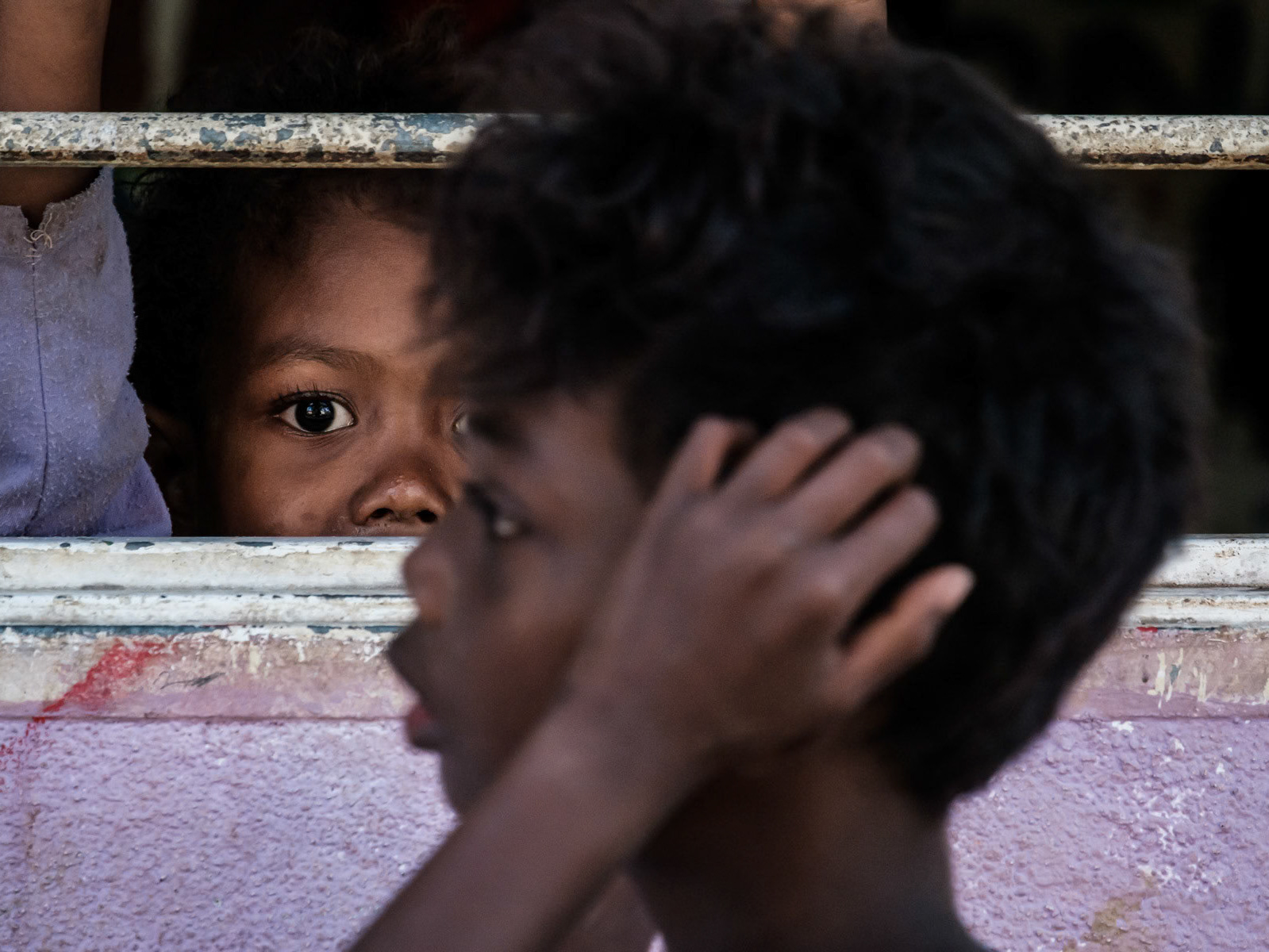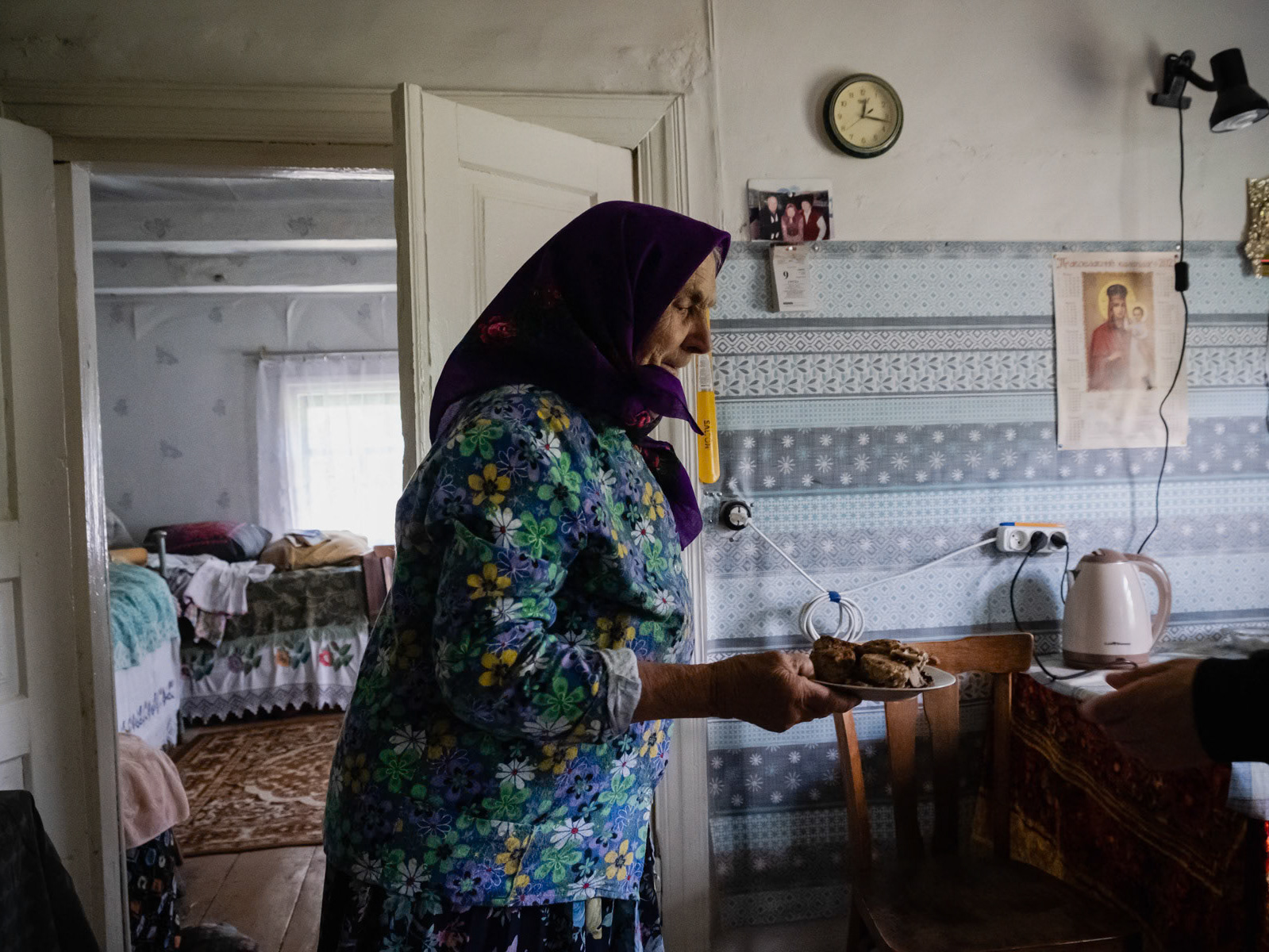Jakarta, the Indonesian capital with a population of over 10 million, is sinking at an alarming rate. Along with rising sea levels, the city is facing severe subsidence, or sinking of the land, caused primarily by the over-extraction of groundwater. Most of Jakarta's water supply comes from underground aquifers, accessed through deep wells, and this excessive withdrawal is destabilizing the ground beneath the city. Experts predict that by 2050, over 95% of northern Jakarta's coastal districts could be submerged.
One major consequence of the city's subsidence is the increasing scale of flooding. As the ground sinks, rivers and rainwater stagnate, unable to flow out to the sea. In particular, the coastal areas where rivers meet the ocean are now below sea level, trapping rainwater and exacerbating flood conditions. In recent decades, pollution has rendered river water too contaminated to serve as a viable source for drinking water. As a result, Jakarta has increasingly relied on deep water wells, a practice that has worsened the situation by depleting the underground aquifers.
Almost half of Jakarta now lies below sea level, and its coastal districts are sinking at an alarming rate of up to 25 cm per year. This rapid subsidence, combined with flooding and severe traffic congestion, has led Indonesian authorities to consider relocating the capital to the island of Borneo within the next few years. Jakarta is sinking faster than any other megacity in the world, outpacing the rise in sea levels caused by global warming.
To combat the sinking city, authorities have initiated the "Great Garuda" project in the Bay of Jakarta. This massive development plan includes a 30-kilometer sea wall and several artificial islands designed to house luxury real estate. The goal is to create an artificial lagoon where water levels can be controlled, allowing the city’s rivers to naturally drain into the sea. Proponents of the project claim it will help prevent deadly floods. However, experts and environmentalists argue that this solution will not stop the city’s sinking. They stress that the only sustainable solution is to stop groundwater extraction altogether and rely on alternative water sources, such as piped water from reservoirs filled with river and rainwater. Efforts to clean and decontaminate rivers, dams, and lakes must be prioritized to ensure a steady and clean water supply.
The social impact of Jakarta’s subsidence is significant, especially for the local population living along the rivers and in the coastal districts. Many neighborhoods are almost permanently flooded or have been reclaimed for real estate projects. Others are being evacuated to make way for river embankments and sea walls, or because the land has become too unstable to inhabit. This has left hundreds of thousands of people in precarious living conditions.
The city's sinking also threatens the livelihoods of fishermen, as the construction of artificial islands and sea walls in the Bay of Jakarta disrupts natural currents and fish populations. Without immediate action, Jakarta’s environmental and social challenges will continue to worsen, with devastating consequences for both its residents and the natural ecosystem.

Jakarta the Indonesian capital of more than 10 million is sinking! As rising sea levels were not bad enough, the capital also suffers of severe subsidence or surface sinking. Its buildings and population extract most of their water needs by drilling water wells into the underground aquifers, rendering it susceptible for collapse. Experts estimate that by 2050 more than 95% northern Jakarta's coastal districts could be submerged. Also, one of the main reasons of the increasing scale of floods in Jakarta is because the city is sinking and that rain water tends to stagnate rather than to wash out to the sea as coastal areas where rivers flow out are under the sea level. During the past decennia river water became too polluted to be used as the main source for piped water, and a shift was made towards digging deep water wells all over the city. This happened in an un-controlled and often illigal way, draining drop by drop the underground aquifers on which the city rests and creating enormeous airpockets making the surface unstable and eventually making the ground to sink and collapse. Almost half of Jakarta lies now below sea level and coastal districts of the city are sinking at an alarming rate of up to 25cm per year! Floodings, subsidence and traffic congestion are the main reasons why the Indonesian authorities want to relocate the capital to the island of Borneo in the next few years. Jakarta is sinking faster than any other mega city in the world, faster than the rise of the sea caused by global warming. One of the massive ongoing (development) projects, which the authorities say will help rescue the city of being submerged, is the "Great Garuda" in the Bay of Jakarta, consisting of a 30 Km outer sea wall along several artificial islands packed with luxary real-estate. The idea is to create and artificial lagoon in which water levels could be controlled and lowered in order to allow the city's rivers to drain naturally into the lagoon and eventually the sea. This in return would help to prevent deadly floods which are becoming a major issue. Experts and environmentalists argue that such project is not going to stop the sinking of the city for which the sole viable solution would be to stop all ground water extraction and only rely on other sources of water such as piped water from reservoirs filled with river and rain water. For this more effort should be invested in decontaminating and cleaning rivers, dams and lakes. The social impact of the city's subsidence, floods and frantic real-estate development is huge on the autochthon population living along the rivers and in the coastal districts. Neighborhoods are being nearly permanently flooded, re-claimed for real-estate projects, or partly evacuated to build concrete river embankments and sea walls, or just because the grounds become to unstable to live on them, pushing soon hundred thousands of people in an extreme precarious situation. Fishermen will in the immediate future have their livelihood compromised as the Bay of Jakarta will become clogged with artificial islands and sea wall affecting natural currents and fish stock. Muara Buru neighbourhood in North Jakarta where most of the soil is sinking at a rate of 10 to 20cm per year. The unstability of the ground is provoked by widespread drilling of water wells for new real estate projects, creating huge air pockets once the water is exhausted. Waduk Pluit, North Jakarta, Indonesia, March 2020

Muara Buru a neighbourhood along the sea shore is partly protected by a seawall against rising sea levels and sinking soil. The soil is sinking at a rate of 10 to 20cm per year. The unstability of the ground is provoked by widespread drilling of water wells for new real estate projects, creating huge air pockets once the water is exhausted. Most of the lands in North Jakarta lay up to 2 metres under sea level. Jakarta, Indonesia, March 2020

Temporary housing for people evicted from their lands where new infrastructure and real estate projects are being developped. Land rights and land ownership is a big problem affecting mainly poor families from the fishing community. Soil sinking, rising sea levels and floods make their living conditions and survival even more precarious. Muara Angke neighbourhood, North Jakarta, Indonesia, March 2020
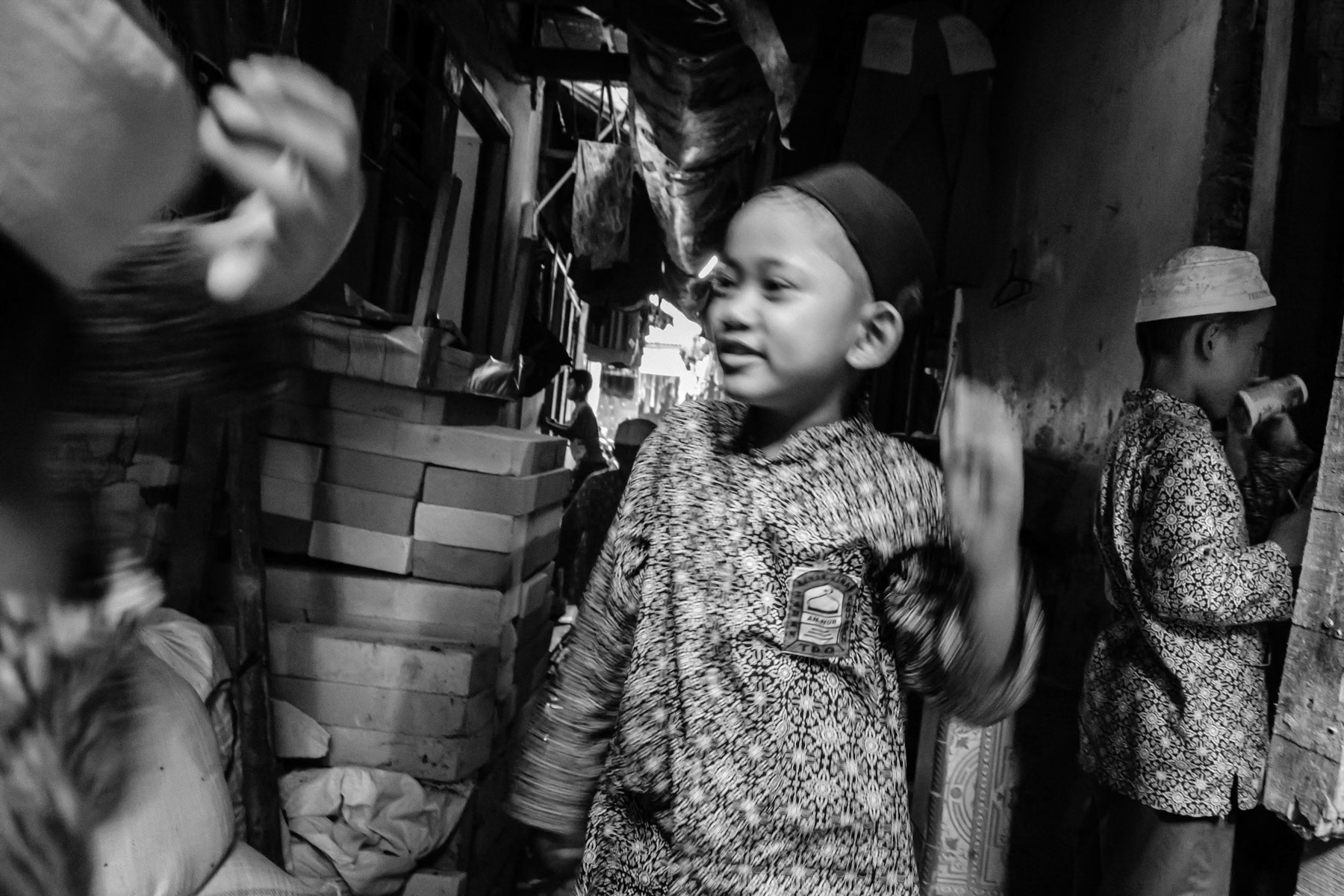
Muara Buru a neighbourhood where the soil is sinking at a rate of 10 to 20cm per year. The unstability of the ground is provoked by widespread drilling of water wells for new real estate projects, creating huge air pockets once the water is exhausted. Most of the lands in North Jakarta lay up to 2 metres under sea level as a result of soil sinking and rising sea levels. North Jakarta, Indonesia, March 2020

Community workers cleaning one of the rivers flowing in Waduk Pluit, an artificial lake from where water will be pumped into the sea. As most of North Jakarta lays now under the sea level, water needs to be pumped out as a prevention for floods. Jakarta, Indonesia, March 2020

Fisherman from Muara Angke reflecting on how fish and crab stocks have been negatively affected in the Bay of Jakarta by large condominium contructions on artificial islands, changing the currents and blocking the flow of water and thus fish. Muara Angke, Jakarta, Indonesia, June 2022

Kids playing and swimming along the seawall built to keep seawater out of the city. As most of North Jakarta lays under the sea level, sea water needs to be kept out and river outflow needs to be pumped out as a prevention for floods. Jakarta, Indonesia, March 2020

Muara Buru a neighbourhood along the seashore is partly protected by a sea wall against rising sea levels and sinking soil. The soil is sinking at a rate of 10 to 20cm per year. The unstability of the ground is provoked by widespread drilling of water wells for new real estate projects, creating huge air pockets once the water is exhausted. North Jakarta, Indonesia, March 2020

Traces of destroyed houses well under the level of a new road. In 2016 the authorities evicted 60 families to construct a wider road and to make a concrete lining along the river, creating a fast water corridor without natural ways to absorb drain water making the floods even more severe than before. Most evicted persons live still in collective centres and have not obtained land rights till now. Bukit Duri, Jakarta, Indonesia, March 2020

Temporary housing for people evicted from their lands where new infrastructure and real estate projects are being developped. Land rights and land ownership is a big problem affecting mainly poor families from the fishing community. Soil sinking, rising sea levels and floods make their living conditions and survival even more precarious. Muara Angke neighbourhood, North Jakarta, Indonesia, March 2020
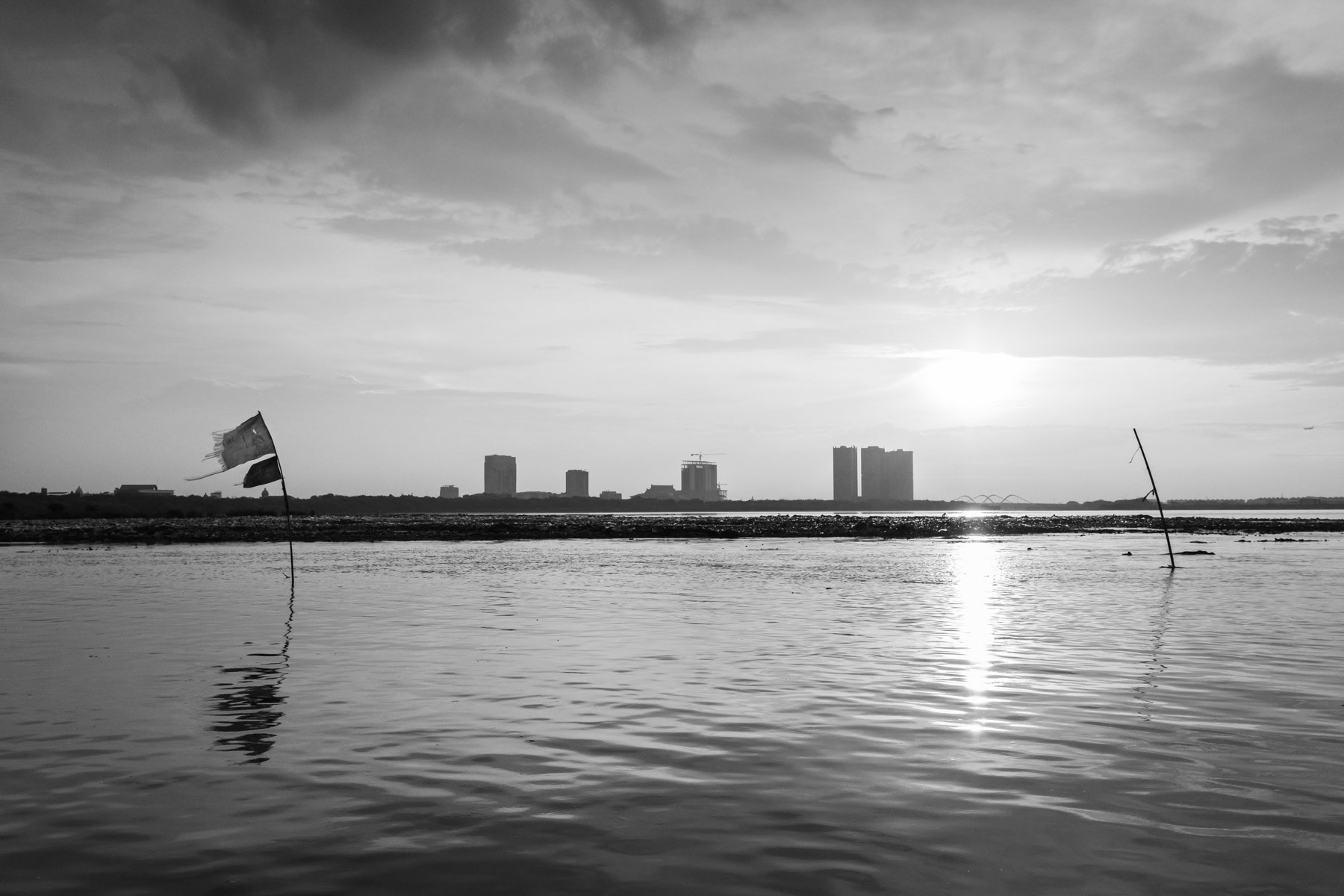
Pantai artificial island being developped as an exclusive real estate secluded area. Such real estate development projects have a very nefast environmental and social impact, such as blocking natural river outflow, depleting drinking water reserves provoking soil sinking, and changing sea currents affecting fish reserves. Muara Angke, Bay of Jakarta, Indonesia, March 2020
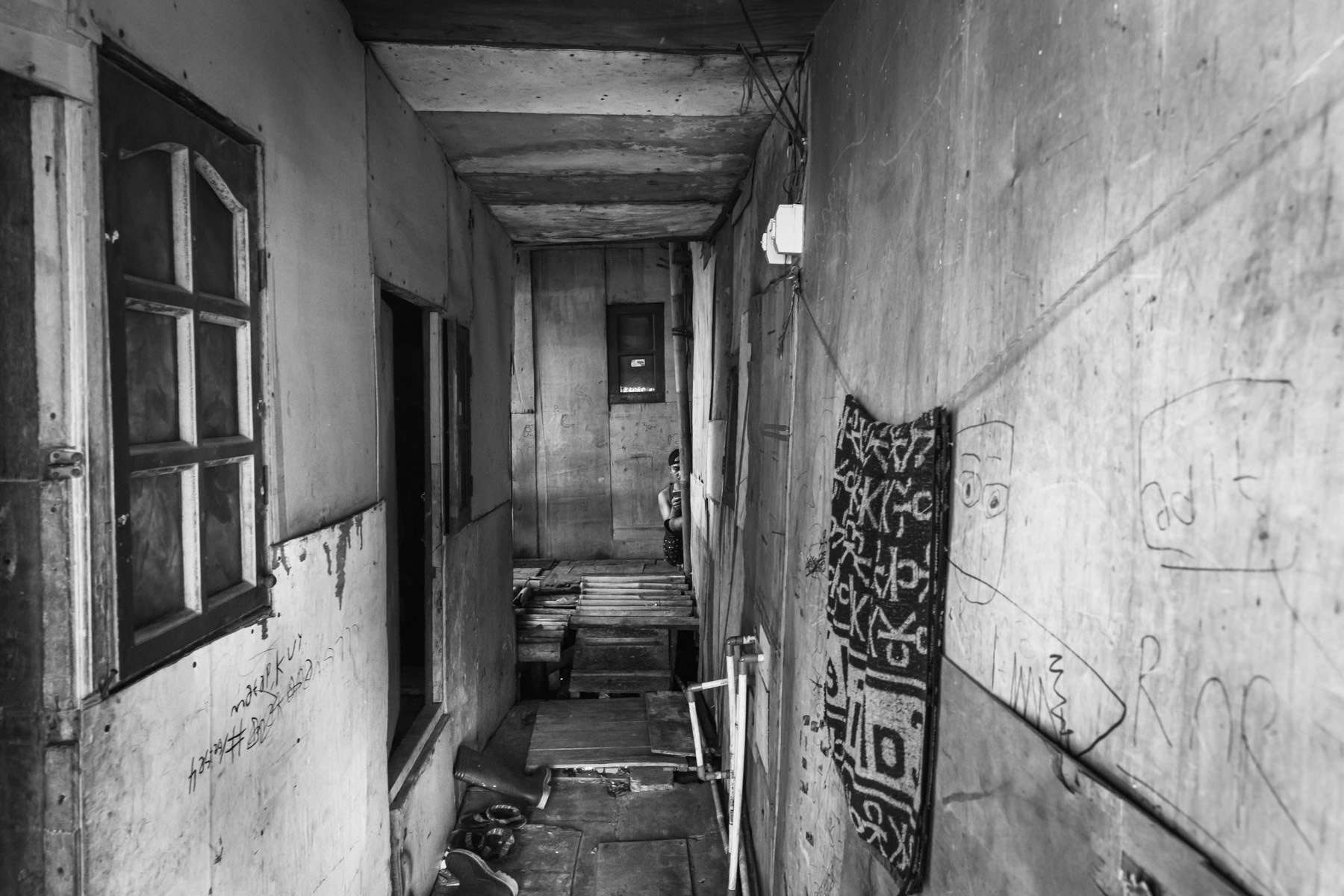
Temporary housing for people evicted from their lands where new infrastructure and real estate projects are being developped. Land rights and land ownership is a big problem affecting mainly poor families from the fishing community. Soil sinking, rising sea levels and floods make their living conditions and survival even more precarious. Muara Angke neighbourhood, North Jakarta, Indonesia, March 2020

Artificial island in the Bay of Jakarta to be further developped as an exclusife real estate secluded cluster as the one in the background. Such real estate development projects have a very nefast environmental and social impact, such as blocking natural river outflow, depleting drinking water reserves provoking soil sinking, changing sea currents affecting fish reserves, and evictions. Muara Angke, Bay of Jakarta, Indonesia, March 2020

Land plot from where people were evicted . Land rights and land ownership is a big issue affecting mainly poor families from the fishing community. Soil sinking, rising sea levels and floods make their survival even more precarious. Muara Angke neighbourhood, North Jakarta, Indonesia, March 2020

Muara Baru neighbourhood along Waduk Pluit, an artificial lake regulating in- and outflows between the river and the Bay of Jakarta. Muara Baru, Jakarta, Indonesia, March 2020

An abandonned mosque on the wrong side of the eawall built against floods provoked by rising sea levels and sinking soil. The soil is sinking at a rate of 10 to 20cm per year. The unstability of the ground is provoked by widespread drilling of water wells for new real estate projects, creating huge air pockets once the water is exhausted. Most of the lands in North Jakarta lay up to 2 metres under sea level accelerating land loss and evictions of indigenous communities, North Jakarta, Indonesia, March 2020

Pantai artificial island being developped as an exclusive real estate secluded area. Such real estate development projects have a very nefast environmental and social impact, such as blocking natural river outflow, depleting drinking water reserves provoking soil sinking, and changing sea currents affecting fish reserves. Pantai artificial island, Jakarta, Indonesia, March 2020

A dam near the pumping station of Waduk Pluit, an artificial lake, regulating in- and outflows between the river and the Bay of Jakarta. Muara Baru, Jakarta, Indonesia, March 2020

Heavy machinery used to keep the outflow of the artificial lake clean. Muara Baru, North Jakarta, Indonesia, March 2020

A poor neighbourhood along the sea shore laying a couple of metres under the sea level due to extensive ground water extraction for real estate projects. The ground is sinking at an average of 10 to 20cm per year in most areas along the shoreline in Northern Jakarta, Indonesia, March 2020

Muara Buru neighbourhood is partly protected by a seawall against rising sea levels and sinking soil. The soil is sinking at a rate of 10 to 20cm per year. The unstability of the ground is provoked by widespread drilling of water wells for new real estate projects, creating huge air pockets once the water is exhausted. North Jakarta, Indonesia, March 2020

Part of the seawall structure built along the shore of the greater Jakarta Bay as a protection against a rising sea. Marunda neighbourhood, Jakarta, Indonesia, June 2022

Land plot from where more and more people are being evicted . Land rights and land ownership is a big issue affecting mainly poor families from the fishing community. Soil sinking, rising sea levels and floods make their survival even more precarious. Muara Angke neighbourhood, North Jakarta, Indonesia, June 2022
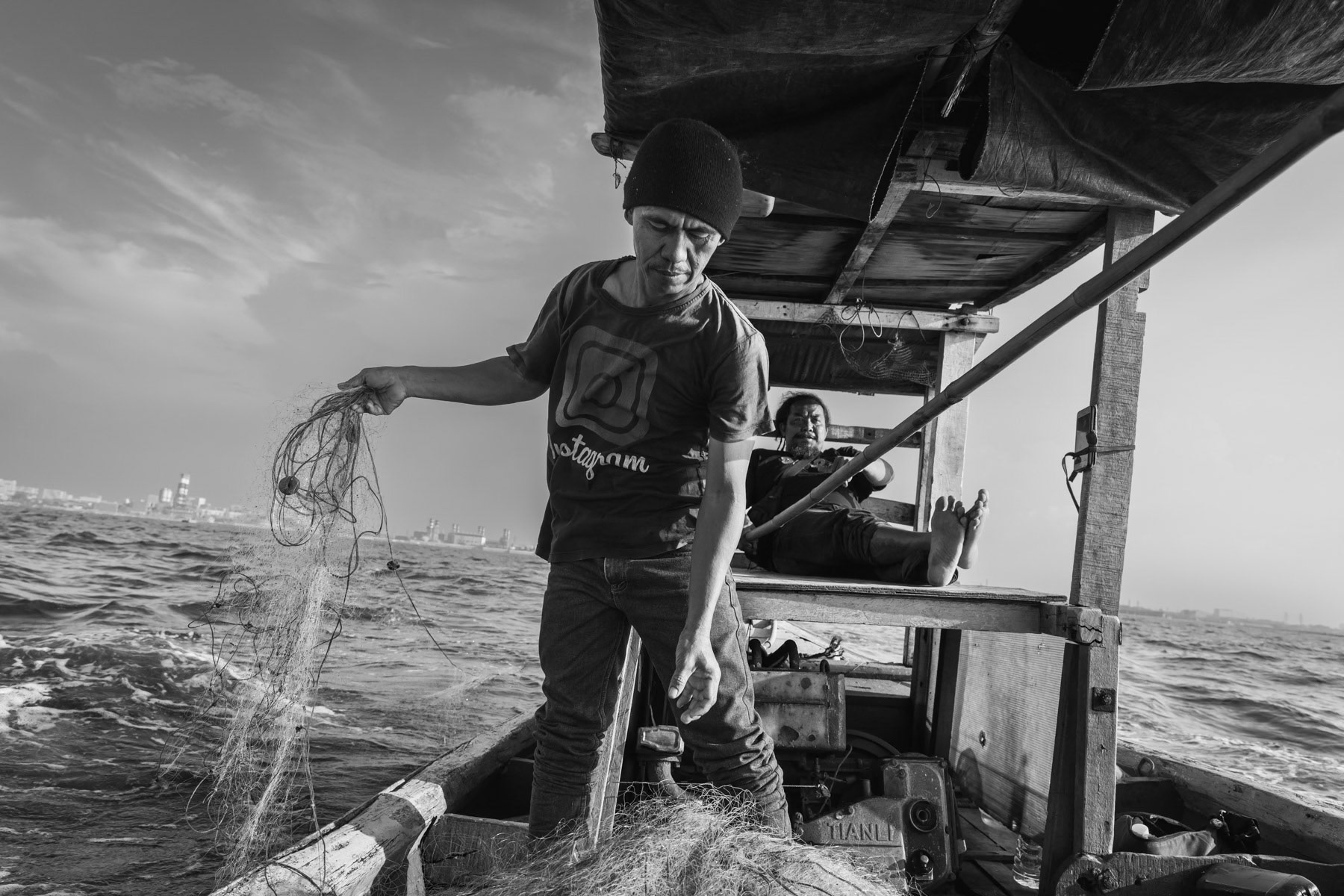
Fisherman from Muara Angke at work, placing his 1 km long fishing net in the Jakarta Bay. Mass construction along the shore of the Jakarta Bay and the creation of artificial islands has depleted the fish stocks, changed the currents, and blocked the outflow of rivers provoking regular floods in the Northern neighbourhoods of Jakarta. Bay of Jakarta, Indonesia, June 2022

Drying fish in Muara Angke. Fishermen have been affected by evictions and depleted fish reserves due to extensive real estate development projects and the construction of artificial islands in the Bay of Jakarta. Muara Angke, Jakarta, Indonesia, June 2022

Temporary housing for people evicted from their lands where new infrastructure and real estate projects are being developped. Land rights and land ownership is a big problem affecting mainly poor families from the fishing community. Soil sinking, rising sea levels and floods make their living conditions and survival even more precarious. Muara Angke neighbourhood, North Jakarta, Indonesia, June 2022

Real estate development project have a very nefast environmental and social impact, such as blocking natural river outflow, depleting drinking water reserves provoking soil sinking, changing sea currents affecting fish reserves, and evictions within the poor coastal communities. Muara Angke, Jakarta, Indonesia, June 2022

Land plot from where people were evicted . Land rights and land ownership is a big issue affecting mainly poor families from the fishing community. Soil sinking, rising sea levels and floods make their survival even more precarious. Muara Angke neighbourhood, North Jakarta, Indonesia, June 2022

Temporary housing for people evicted from their lands where new infrastructure and real estate projects are being developped. Land rights and land ownership is a big problem affecting mainly poor families from the fishing community. Soil sinking, rising sea levels and floods make their living conditions and survival even more precarious. Muara Angke neighbourhood, North Jakarta, Indonesia, June 2022

Temporary housing for people evicted from their lands where new infrastructure and real estate projects are being developped. Land rights and land ownership is a big problem affecting mainly poor families from the fishing community. Soil sinking, rising sea levels and floods make their living conditions and survival even more precarious. Muara Angke neighbourhood, North Jakarta, Indonesia, June 2022

Temporary housing for people evicted from their lands where new infrastructure and real estate projects are being developped. Land rights and land ownership is a big problem affecting mainly poor families from the fishing community. Soil sinking, rising sea levels and floods make their living conditions and survival even more precarious. Muara Angke neighbourhood, North Jakarta, Indonesia, June 2022

Muara Buru a neighbourhood along the seashore is partly protected by a seawall against rising sea levels and sinking soil. The soil is sinking at a rate of 10 to 20cm per year. The unstability of the ground is provoked by widespread drilling of water wells for new real estate projects, creating huge air pockets once the water is exhausted. Most of the lands in North Jakarta lay up to 2 metres under sea level. Jakarta, Indonesia, June 2022

Fishmarket of Muara Angke. Fishermen have been affected by evictions and depleted fish reserves due to extensive real estate development projects and the construction of artificial islands in the Bay of Jakarta. Muara Angke, Jakarta, Indonesia, June 2022







